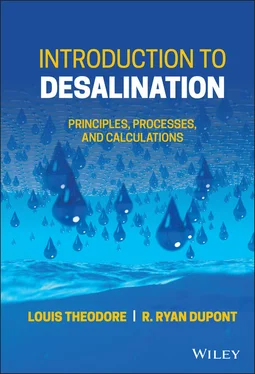As noted in the Table of Contents, this desalination book is divided into three parts:
Part I: Introduction
Part II: Desalination and Water Treatment Processes
Part III: Select Related Topics
Part I includes the following chapters: Global Water Scarcity and the Need for “New Water;” a Technical Glossary; Engineering Principles; Physical, Chemical, and Biological Properties of Water; Water Chemistry; Conservation Laws; Unit Operations; and Heat Transfer and Thermodynamic Principles. Part II then introduces the desalination process. Part II highlights specific processes including: Evaporation, Reverse Osmosis, Crystallization, Other Desalination Processes, New Desalination Processes, and Other Potable Water Treatment Processes. These seven chapters are generously supplemented with illustrative examples. Part III contains five chapters that are concerned with what the authors have termed, “Select Related Topics,” i.e. Water Conservation, Economic Considerations, Optimization, Ethics, and The Future of Desalination.
The authors hope that this book will place in the hands of academic, industrial, and government personnel – including policy makers and water resource /management planners – a book that covers the fundamental principles and applications of desalination in a thorough and clear manner. The authors further hope that, on completion of the text, readers will have acquired not only a working knowledge of the principles of desalination, but also experience in their application; and, that they will find themselves approaching advanced texts, engineering and science literature, and industrial applications (even unique ones )with more confidence.
Last, but not least, the authors believe that this modest work will help the majority of individuals working and /or studying in the field of desalination to obtain a more complete understanding of this subject matter. If you have come this far and read through this Preface, you have more than just a passing interest in this subject. We strongly recommend that you take advantage of the material available in this book. We think that it will be a worthwhile experience.
East Williston, NY, January 2022 Louis Theodore
Smithfield, UT, January 2022 R. Ryan Dupont
Whisky is for drinkin’, water is for fightin’
Anonymous
To all the members of East Williston Fire Department, but in particular: Billy Behan, Angelo Carbone Jr., Domenic Conte, Steve Jones, Billy McLean Jr., and a host of others .
and
In loving memory of Marie K. and Robert H. Dupont
Chapters in this Part include the following:
Global Water Scarcity and the Need for “New Water”
Technical Glossary
Engineering Principles
Physical, Chemical, and Biological Properties of Materials
Water Properties
Water Chemistry
The Conservation Laws, Stoichiometry, and Thermodynamics
Unit Operations
1 Global Water Scarcity and the Need for “New Water”
1.1 Introduction
The title of this book includes the word desalination . Dictionary.com(2012) defines desalination as “the process of removing salt, esp from seawater so that it can be used for drinking or irrigation.” Thus, desalination is a process that produces potable water. The reader should keep in mind, and this will be discussed later in the book, that there are other processes available for producing potable water, many of which are currently uneconomical. For this reason, the book primarily deals with desalination. The general topic of potable water is also considered and is addressed in several of the paragraphs to follow.
The world’s total water is enormous compared with the presently conceivable needs of man, yet there is a growing water problem. Of the 1.39 billion km 3(332 million mi 3) of water in the Earth’s crust 99% is salty and useful neither for irrigation by present techniques nor for the majority of man’s other needs.
Rain provides many times the world’s annual water needs, but fresh water supplies vary widely over the Earth and from time to time in a given region. This accounts for the “water problem” that exists as the Earth’s population continues to grow. In the United States, the actual “consumptive use” is approximately 12%–18% of the potential supply. Water prices are low, and on a statistical basis there should be no water shortages for many years. These average figures are of little comfort to the people of arid regions, however, and the United States, though relatively well supplied with water, is now beginning to turn to sources other than rainfall and runoff to meet growing water demands. The Southwest has too little water to support rapid population expansion. California has embarked on multi-billion dollar projects to bring water nearly 800 miles to Los Angeles and southern California from the wetter northern parts of the state. Outside of the United States, expensive desalination plants have been in operation for many years in the Virgin Islands, many Persian Gulf states, the West Indies, Libya, South Africa, and Israel.
An obvious way to increase water availability is to recover fresh water from seawater or large underground stores of brackish water that are available in many arid regions, but that are generally not usable without significant treatment. Other options for increasing potable water supplies is to find ways to use the saline or brackish water for agriculture or other uses that can tolerate higher salinity levels, or to actively pursue water conservation measures to protect limited fresh water supplies that may be available.
This chapter introduces the reader to the general subject of global water supplies and water scarcity issues through a review of water availability and water sources, global water resources, global water resource issues, and the history of desalination. A series of illustrative examples are provided to highlight concepts presented throughout the chapter.
1.2 Water Availability and Water Sources
The water on the surface of the Earth can be found in eight distinct compartments which are shown in Table 1.1along with how much of the Earth’s total water budget each makes up. These eight compartments are more commonly organized into three distinct groupings. First, there is surface water , which includes oceans, lakes, rivers, seas, etc. In short, surface water is all forms of liquid water that lie on the surface of the Earth. The second grouping is glacial and frozen water . These are resources that are located on the surface; however, these resources are in frozen, long-term storage. Long-term storage is defined as water that has historically taken thousands of years to move through the water cycle. The third and final grouping is groundwater . This is the water that is found below the surface of the Earth in conditions where the percent saturation in soil pore water is 100% (Mullen 2021). The process known as the hydrologic, or water cycle , has played a crucial role in the formation and distribution of all water resources on Earth today. The water cycle is used to describe the constant circulation of water through its three phases of solid, liquid, and gas as it moves within the eight compartments making up the water resource pool on the Earth.
Table 1.1 Breakdown of the total water budget on the Earth.
| Water compartment |
% of Total Earth’s water budget |
| Oceans |
97.2 |
| Frozen glacier water & other ice |
2.15 |
| Ground or subsurface water |
0.61 |
| Freshwater lakes |
0.009 |
| Inland seas |
0.008 |
| Soil moisture |
0.005 |
| Atmospheric water |
0.001 |
| Rivers and streams |
0.001 |
1.3 Global Water Resources
Читать дальше












